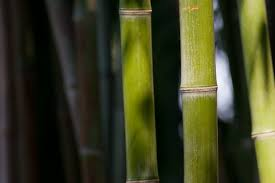Bamboo
Scientific names: Bambusa vulgaris
Climate: All climates. It is native to warm and humid tropical temperate climates but grows in cold mountain regions and highland cloud forests
Plant description: Bamboos grow from six to 18 meters in height and with diameters of up to ten cm. The stems grow together. It has long, thin green leaves and the stem is yellow with green stripes or simply green.
Cultivation: To make stem cuttings, they must be cut during the first two years. The cuttings should be around 30 cm long with two or three nodes at the base. Plant vertically (preferably at a slight angle), either in bags, in raised beds, or beds made of bamboo so that the rhizomatous base and a nodule remain covered in soil and at least one or two nodes are above the surface. They are kept in partial shade and the soil is watered daily. The first sprout and root should appear three to four weeks later. However, you should leave the bamboo plants in the bags for six months or a year. The new bamboo plants will be ready to be transplanted in the next rainy season. Sow at a distance of five meters between plants and between rows.
Tolerates partial shade or full sun but partial shade is preferred to grow cuttings. It can grow in many types of soils, but it prefers good drainage and does not tolerate the seashore well.
The best way to keep the plant strong and healthy is to prune it to remove weak, damaged or old branches. If bamboo plants are spaced too far apart, the plantation will suffer loss of soil moisture through evaporation and competition from weeds and other vegetation. Overly dense planting will lead to bamboo plants competing with each other for light, space, soil moisture, and nutrients.
 Uses: It has many uses. It is an ideal natural barrier and helps prevent erosion. Bamboo sticks are used in carpentry and construction, to make tool handles and fishing rods, firewood and even paper. Bamboo is used in traditional medicine in China, India, and Africa. Its leaves are sweet and help to reduce fever (boiled and used for bathing, or taken as tea to induce sweating), to regulate the flow of the menstrual period, to heal wounds, to improve heart problems and malaria. The stems are used to relieve rheumatic pain. Bamboo shoots are eaten after boiling for half an hour with salt to remove toxins. These are also used to regularize menstrual flow, to treat abscesses and malaria.
Uses: It has many uses. It is an ideal natural barrier and helps prevent erosion. Bamboo sticks are used in carpentry and construction, to make tool handles and fishing rods, firewood and even paper. Bamboo is used in traditional medicine in China, India, and Africa. Its leaves are sweet and help to reduce fever (boiled and used for bathing, or taken as tea to induce sweating), to regulate the flow of the menstrual period, to heal wounds, to improve heart problems and malaria. The stems are used to relieve rheumatic pain. Bamboo shoots are eaten after boiling for half an hour with salt to remove toxins. These are also used to regularize menstrual flow, to treat abscesses and malaria.
Pests and diseases: Bamboo has large amounts of starch (sugars), which are the main nutrients for parasites, perforators and fungi. Consumption of this plant causes neurological disease in horses.1
Harvesting bamboo at the end of a dry season increases the chances of fungal attacks. The best time to harvest bamboo is at the end of the rainy season or the beginning of the dry season.
References:
En español: Bambú

